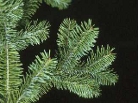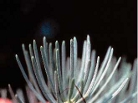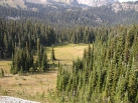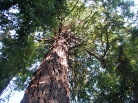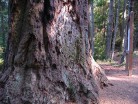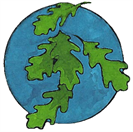
Bristlecone Fir,
Abies bracteata (D. Don) Nutt.
Abies bracteata (D. Don) Nutt.
The fir with the lightest needles is the Colorado Fir however. Bristlecone fir needles are flat, 1.5 to 2.5 inches long, upcurved, have white bands called stomata along the length of the lower side, and are generally 2 ranked. Found in the upper portion of the crown are the female cones which distinguish it from all other native firs. The outstanding feature of these cones, which earn this species its namesake, are the long (.5 to 1.5 inch), slender, golden brown, needle like bracts sticking out from the scale tips, giving it a bristly appearance. The cones themselves are light purplish brown, 3 to 4 inches long and contain winged seeds which are mostly dispersed by
Sources:
Trees of North America- A guide to field identification-a Golden Field Guide from St. Martin's Press © 2002 By C. Frank Brockman p.30
The Encyclopedia of North American Trees by Sam Benvie. Firefly Books Ltd., 2000 Buffalo, NY © 2000 Sam Benvie p.25
USDA, NRCS. 2011. The PLANTS Database (<http://plants.usda.gov/>, 22 August 2011). National Plant Data Team, Greensboro, NC 27401-4901 USA.
Sullivan, Janet 1993. Abies bracteata. In: Fire Effects Information System, [Online]. U.S. Department of Agriculture, Forest Service, Rocky Mountain Research Station, Fire Sciences Laboratory (Producer). Available: http://www.fs.fed.us/database/feis/ [2011, August 22].
Conifers.org, Abies bracteata
Virginia Tech. Department of Forest Resources and Environmental Conservation for Abies bracteata
Trees of North America- A guide to field identification-a Golden Field Guide from St. Martin's Press © 2002 By C. Frank Brockman p.30
The Encyclopedia of North American Trees by Sam Benvie. Firefly Books Ltd., 2000 Buffalo, NY © 2000 Sam Benvie p.25
USDA, NRCS. 2011. The PLANTS Database (<http://plants.usda.gov/>, 22 August 2011). National Plant Data Team, Greensboro, NC 27401-4901 USA.
Sullivan, Janet 1993. Abies bracteata. In: Fire Effects Information System, [Online]. U.S. Department of Agriculture, Forest Service, Rocky Mountain Research Station, Fire Sciences Laboratory (Producer). Available: http://www.fs.fed.us/database/feis/ [2011, August 22].
Conifers.org, Abies bracteata
Virginia Tech. Department of Forest Resources and Environmental Conservation for Abies bracteata
Ovulate Bristlecone Fir cone.
Photo citation: © 1995 Saint Mary's College of California,
Brother Alfred Brousseau
Photo citation: © 1995 Saint Mary's College of California,
Brother Alfred Brousseau
Common Names: Santa Lucia Fir, Silver Fir
State List: CA
Visit the Image Gallery for more pictures
Synonyms: Abies bracteata D. Don ex Poiteau
Abies venusta (Dougl.) K. Koch
State List: CA
Visit the Image Gallery for more pictures
Synonyms: Abies bracteata D. Don ex Poiteau
Abies venusta (Dougl.) K. Koch
North American native distribution range for Abies braceata, Bristlecone Fir
Map courtesty USDA NRCS PLANTS Database
Map courtesty USDA NRCS PLANTS Database

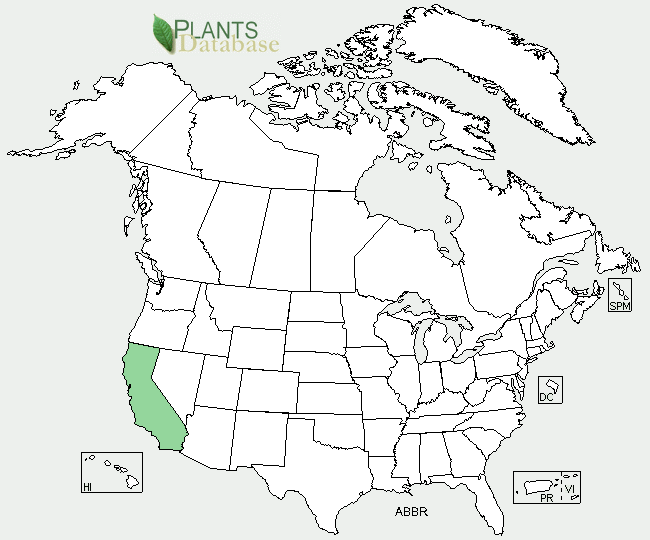
Cited as the rarest fir in the world, the bristlecone fir is a native conifer found only in the Los Padres National Forest of Big Sur, California. Discovered in 1831 by Thomas Coulter, this evergreen tree species usually grows between 30 and 100 feet but under optimal conditions, Abies bracteata may reach 150 feet in height and 3 feet in diameter. A medium sized and slow growing tree species, the crown is spire like, and unusual for a fir, it has dense, persistent lower branches close to the ground. Both branch and twig tips often curve up at the ends. The bud scales are non-resinous. Unlike most fir trees, which have deep dark green needles, those of the bristlecone fir are much lighter.

wind. Flowering in May, male flowers are yellow and are found underneath the needles. A. bracteata has thin, reddish-brown bark that ranges from smooth to scaly or slightly ridged and furrowed.
Habitat
In the Santa Lucia Mountains on rocky or gravelly sites of granite origin and between elevations of 700 and 5,200 feet, dwell the small populations of Bristlecone Fir. Their limited range makes them rare and it has been put on a 'Watch List' by the California Native Plant Society. It is not, however, classified as endangered or threatened as populations are stable. It prefers mild climates consisting of moist cool summers where it is bathed in fog, followed by mild winters. Annual rainfall needs are 35 to 40 inches and will show signs of stress when adequate water is not available. This native tree is a shade species and is prone to sun scorch when suddenly exposed to or grown in direct sunlight. A. bractaeta is extremely fire sensitive and it has been suggested that fire plays a crucial role in the success and even site location of this species. Seemingly, the only old growth stands of bristlecone fir occur almost exclusively on fireproof sites with little to no flammable ground cover. Seed germination is best at temperatures below 73°F with large seed crops occuring every 3 to 5 years.
Pests, Diseases, and Elements
The seeds are highly parasitized by chalcids, sometimes consuming up to 100% of the years crop. In addition to being fire senstive, Bristlecone Fir
Habitat
In the Santa Lucia Mountains on rocky or gravelly sites of granite origin and between elevations of 700 and 5,200 feet, dwell the small populations of Bristlecone Fir. Their limited range makes them rare and it has been put on a 'Watch List' by the California Native Plant Society. It is not, however, classified as endangered or threatened as populations are stable. It prefers mild climates consisting of moist cool summers where it is bathed in fog, followed by mild winters. Annual rainfall needs are 35 to 40 inches and will show signs of stress when adequate water is not available. This native tree is a shade species and is prone to sun scorch when suddenly exposed to or grown in direct sunlight. A. bractaeta is extremely fire sensitive and it has been suggested that fire plays a crucial role in the success and even site location of this species. Seemingly, the only old growth stands of bristlecone fir occur almost exclusively on fireproof sites with little to no flammable ground cover. Seed germination is best at temperatures below 73°F with large seed crops occuring every 3 to 5 years.
Pests, Diseases, and Elements
The seeds are highly parasitized by chalcids, sometimes consuming up to 100% of the years crop. In addition to being fire senstive, Bristlecone Fir

Bristlecone Fir. Photo citation: © 1995 Saint Mary's College of California, Brother Alfred Brousseau
is also drought sensitive, saplings in particular, so care should be taken in landscape applications to ensure moisture needs are met.
Uses
As with other tree species with low population numbers, there is no commercial value for Bristlecone fir. Throughout California, it is becoming a popular ornamental species where conditions are favorable for growth. Historically, the resin was used in pioneer Spanish missions and settlements as incense
Uses
As with other tree species with low population numbers, there is no commercial value for Bristlecone fir. Throughout California, it is becoming a popular ornamental species where conditions are favorable for growth. Historically, the resin was used in pioneer Spanish missions and settlements as incense



Saturday, May 24, 2025

|
|
|
|
|
| A-Z scientific | ||
| A-Z by Common Name | ||
| Families | ||
| Browse by State | ||
| Rare or Endangered Species | ||
| Trees_with_Special_Uses | ||
| Tallest and Biggest |
| Aceraceae Maple Family | ||
| Anacardiaceae Sumac Family | ||
| Annonaceae Custard Apple Family | ||
| Aquifoliaceae Holly Family | ||
| Arecaceae, Palm Family | ||
| Betulaceae Birch family | ||
| Bignoniaceae Trumpet Creeper Family | ||
| Burseraceae Frankincense Family | ||
| Caprifoliaceae Honeysuckle Family | ||
| Chrysobalanaceae Coco-plum Family | ||
| Cornaceae Dogwood Family | ||
| Cupressaceae Cypress Family | ||
| Cyrillaceae Cyrilla Family | ||
| Ebenaceae Ebony Family | ||
| Ericaceae Heath Family | ||
| Fabaceae Pea Family | ||
| Fagaceae Beech Family | ||
| Hamamelidaceae Witch Hazel Ffamily | ||
| Hippocastanaceae Horse Chestnut Family | ||
| Juglandaceae Walnut Family | ||
| Lauraceae Laurel Family | ||
| Leitneriaceae Corkwood Family | ||
| Magnoliaceae Magnolia Family | ||
| Meliaceae Mahogany Family | ||
| Moraceae Mulberry Family | ||
| Myricaceae Bayberry Family | ||
| Myrsinaceae Myrsine Family | ||
| Myrtaceae Myrtle Family | ||
| Nyctaginaceae Four Oclock Family | ||
| Olacaceae Olax Family | ||
| Oleaceae Olive Family | ||
| Pinaceae Pine Family | ||
| Platanaceae Plane Tree Family | ||
| Polygonaceae Buckwheat Family | ||
| Rhamnaceae Buckthorn Family | ||
| Rosaceae Rose Family | ||
| Rubiaceae Madder Family | ||
| Rutaceae Rue Family | ||
| Salicaceae Willow Family | ||
| Sapindaceae Soapberry Family | ||
| Sapotaceae Sapodilla Family | ||
| Simaroubaceae Quassia Family | ||
| Styracaceae Storax Family | ||
| Symplocaceae Sweetleaf Family | ||
| Theaceae Tea Family | ||
| Tiliaceae Lindon Family | ||
| Ulmaceae Elm Family | ||
| Taxaceae Yew Family | ||
| Yucca Family |
| Maple A-Z |
| sumac_family_a-z |
| custard_apple_family_a-z |
| holly_trees_a-z |
| palm_family_a-z |
| birch_family_a-z |
| trumpet_creeper_family_a-z |
| honeysuckle_family_a-z |
| dogwood_family_a-z |
| cypress_family_a-z |
| heath_family_a-z |
| pea_family_a-z |
| beech_family_a-z |
| walnut_family_a-z |
| magnolia_family_a-z |
| olive_family_a-z |
| rose_family_a-z |
| willow_family_a-z |
| franklinia |
| elm_family_a-z |
| Federal List | ||
| State Lists | ||
| Invasive_species |
| Restoration of the American Chestnut | ||
| Restoration of the American Elm | ||
| Sustainable Forestry |
| Contact Us | ||
| Our Contributors | ||
| Photo of the Month | ||
| Usage Requirements | ||
| FAQ | ||
| Report a Broken Link |
| photo_submission |
| Photo Store |
™

Want to add your tree to our picture gallery? Click here for details!
Tree lists:
•A-Z by scientific
name
•A-Z by common
name
•By Family
For state A-Z list click state name below.
•A-Z by scientific
name
•A-Z by common
name
•By Family
For state A-Z list click state name below.
-Color denotes a tree that is rare or endangered


Custom Search
